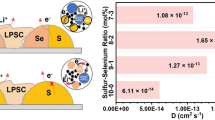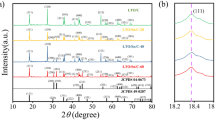Abstract
The high theoretical energy density and superior safety of all-solid-state lithium-sulfur batteries (ASSLSBs) make them a promising candidate for large-scale energy storage applications. The sulfur active material used in the positive electrode exhibits a higher power density compared to the lithium sulfide active material employed in the electrode. However, the limited utilization of sulfur in the positive electrode is due to its low ionic and electronic conductivity. Herein, sulfur is confined within porous carbon (S/C) by vapor deposition to ensure electronic conductivity. Subsequently, LiX additives (where X = F, Cl, Br, and I) are introduced into the S/C composite to enhance ionic conductivity. In situ electrochemical impedance spectroscopy (EIS) with distribution of relaxation times (DRT) analysis and electrochemical evaluations demonstrated that the introduction of LiI additives significantly enhances ion transfer on the S/C composite, thereby improving its reaction electrochemical reaction activity during cycling. The electrochemical performance of ASSLSBs with LiX additives on S/C composite generally exhibits a decreasing trend in the order of LiI > LiBr > LiCl > LiF. The S/C composite with LiI additives (S/C@LiI) cathode employed in ASSLSBs demonstrated an impressive high discharge capacity of 2016.9 mAh g−1 after 275 cycles with a capacity retention of 100% and a reversible discharge capacity of 627.1 mAh g−1 at 1C for up to 450 cycles.
Graphical abstract
The introduction of LiI additives enhances ion transfer on the S/C composite cathode demonstrated by the in situ EIS and DRT analysis, thereby improving the electrochemical performance.







Similar content being viewed by others
Data availability
Data is available on request from the authors.
References
Mu Q, Liu R, Kimura H et al (2023) Supramolecular self-assembly synthesis of hemoglobin-like amorphous CoP@N, P-doped carbon composites enable ultralong stable cycling under high-current density for lithium-ion battery anodes. Adv Compos Hybrid Mater 6:23
Hou C, Yang W, Kimura H et al (2023) Boosted lithium storage performance by local build-in electric field derived by oxygen vacancies in 3D holey N-doped carbon structure decorated with molybdenum dioxide. J Mater Sci Technol 142:185–195
Yang W, Peng D, Kimura H et al (2022) Honeycomb-like nitrogen-doped porous carbon decorated with Co3O4 nanoparticles for superior electrochemical performance pseudo-capacitive lithium storage and supercapacitors. Adv Compo Hybrid Mater 5:3146–3157
Ma Y, Hou C, Kimura H et al (2023) Recent advances in the application of carbon-based electrode materials for high-performance zinc ion capacitors: a mini review. Adv Compo Hybrid Mater 6:59
Ma Y, **e X, Yang W et al (2021) Recent advances in transition metal oxides with different dimensions as electrodes for high-performance supercapacitors. Adv Compo Hybrid Mater 4:906–924
Dang C, Mu Q, **e X et al (2022) Recent progress in cathode catalyst for nonaqueous lithium oxygen batteries: a review. Adv Compo Hybrid Mater 5:606–626
Zhang Y, Liu L, Zhao L et al (2022) Sandwich-like CoMoP2/MoP heterostructures coupling N, P co-doped carbon nanosheets as advanced anodes for high-performance lithium-ion batteries. Adv Compo Hybrid Mater 5:2601–2610
Li H, Liu D, Zhu X et al (2020) Integrated 3D electrodes based on metal-nitrogen-doped graphitic ordered mesoporous carbon and carbon paper for high-loading lithium-sulfur batteries. Nano Energy 7:104763
Li S, Zhang W, Zheng J et al (2020) Inhibition of polysulfide shuttles in Li-S batteries: modified separators and solid-state electrolytes. Adv Energy Mater 11:2000779
Tu H, Li L, Hu Y et al (2022) Non-flammable liquid polymer-in-salt electrolyte enabling secure and dendrite-free lithium metal battery. Chem Eng J 434:134647
Wang C, Liang J, Zhao Y et al (2021) All-solid-state lithium batteries enabled by sulfide electrolytes: from fundamental research to practical engineering design. Energy Environ Sci 14:2577–2619
Muy S, Bachman J, Giordano L et al (2018) Tuning mobility and stability of lithium ion conductors based on lattice dynamics. Energy Environ Sci 11:850–859
Wang D, Zeng Q, Zhou G et al (2013) Carbon–sulfur composites for Li–S batteries: status and prospects. J Mater Chem A 1:9382–9394
Ohno S, Rosenbach C, Dewald G et al (2021) Linking solid electrolyte degradation to charge carrier transport in the thiophosphate-based composite cathode toward solid-state lithium-sulfur batteries. Adv Funct Mater 31:2010620
Ding B, Wang J, Fan Z et al (2020) Solid-state lithium-sulfur batteries: advances, challenges and perspectives. Mater Today 40:114–131
Wang X, Zhang J, Wang R et al (2023) Stable all-solid-state Z-scheme heterojunction Bi2O3-Co3O4@C microsphere photocatalysts for recalcitrant pollutant degradation. J Alloys Compd 940:168915
Wang X, ** S, Cui Y et al (2023) Photocatalytic activity of Co3O4@C enhanced by induction of amorphous cobalt-based MOF. Colloid Surface A 657:130597
Long P, Xu Q, Peng G et al (2016) NiS nanorods as cathode materials for all-solid-state lithium batteries with excellent rate capability and cycling stability. ChemElectroChem 3:764–769
Zhang Q, Yao X, Mwizerwa J et al (2018) FeS nanosheets as positive electrodes for all-solid-state lithium batteries. Solid State Ion 318:60–64
Wu H, Huan Y, Wang D et al (2019) Hierarchical VS2 nano-flowers as sulfur host for lithium sulfur battery cathodes. J Electrochem Soc 166:A188–A194
Cheng Z, **ao Z, Pan H et al (2018) Elastic sandwich-type rGO-VS2/S composites with high tap density: structural and chemical cooperativity enabling lithium-sulfur batteries with high energy density. Adv Energy Mater 8:1702337
Liu X, Huang J, Zhang Q et al (2017) Nanostructured metal oxides and sulfides for lithium-sulfur batteries. Adv Mater 29:1601759
Chen X, Du G, Zhang M et al (2019) Vanadium sulfide@sulfur composites as high-performance cathode for advanced lithium–sulfur batteries. Energy Technol 8:1901163
Phuc N, Hikima K, Muto H et al (2021) Recent developments in materials design for all-solid-state Li–S batteries. Crit Rev Solid State Mater Sci 47:283–308
Dewald G, Ohno S, Hering J et al (2020) Analysis of charge carrier transport toward optimized cathode composites for all-solid-state Li-S batteries. Batteries Supercaps 4:183–194
Hakari T, Fujita Y, Deguchi M et al (2022) Solid electrolyte with oxidation tolerance provides a high-capacity Li2S-based positive electrode for all-solid-state Li/S batteries. Adv Funct Mater 32:2106174
Hakari T, Hayashi A, Tatsumisago M (2017) Li2S-based solid solutions as positive electrodes with full utilization and superlong cycle life in all-solid-state Li/S batteries. Adv Sustain Syst 1:1700017
Fujita Y, Sakuda A, Hasegawa Y et al (2023) High capacity Li(2)S-Li(2)O-LiI positive electrodes with nanoscale ion-conduction pathways for all-solid-state Li/S batteries. Small. https://doi.org/10.1002/smll.20232179
Wan H, Zhang B, Liu S et al (2021) Understanding LiI-LiBr catalyst activity for solid state Li2S/S reactions in an all-solid-state lithium battery. Nano Lett 21:8488–8494
Jiang J, Fan Q, Chou S et al (2021) Li(2) S-based Li-ion sulfur batteries: progress and prospects. Small 17:e1903934
Li H, Song J, Wu F et al (2023) Metal-nitrogen-doped hybrid ionic/electronic conduction triple-phase interfaces for high-performance all-solid-state lithium-sulfur batteries. Nano Res. https://doi.org/10.1007/s12274-023-5815-7
Alzahrani A, Otaki M, Wang D et al (2021) Confining sulfur in porous carbon by vapor deposition to achieve high-performance cathode for all-solid-state lithium–sulfur batteries. ACS Energy Lett 6:413–418
Agostini M, Aihara Y, Yamada T et al (2013) A lithium-sulfur battery using a solid, glass-type P2S5-Li2S electrolyte. Solid State Ion 244:48–51
Wan T, Saccoccio M, Chen C et al (2015) Influence of the discretization methods on the distribution of relaxation times deconvolution: implementing radial basis functions with DRTtools. Electrochim Acta 184:483–499
Liu J, Ciucci F (2020) The Gaussian process distribution of relaxation times: a machine learning tool for the analysis and prediction of electrochemical impedance spectroscopy data. Electrochim Acta 331:135316
Han F, Yue J, Fan X et al (2016) High-performance all-solid-state lithium-sulfur battery enabled by a mixed-conductive Li2S nanocomposite. Nano Lett 16:4521–4527
Chen B, Deng S, Jiang M et al (2022) Intimate triple phase interfaces confined in two-dimensional ordered mesoporous carbon towards high-performance all-solid-state lithium-sulfur batteries. Chem Eng J 448:137712
Fan B, Guan Z, Wang H et al (2021) Electrochemical processes in all-solid-state Li-S batteries studied by electrochemical impedance spectroscopy. Solid State Ion 368:115680
Illig J, Ender M, Chrobak T et al (2012) Separation of charge transfer and contact resistance in LiFePO4-cathodes by impedance modeling. J Electrochem Soc 159:A952–A960
Ellen I, Andre W (2017) Evaluation of electrochemical impedance spectra by the distribution of relaxation times. J Ceram Soc Jpn 125:193–201
Lu Y, Zhao C, Huang J et al (2022) The timescale identification decoupling complicated kinetic processes in lithium batteries. Joule 6:1172–1198
Lu Y, Zhao C, Zhang R et al (2021) The carrier transition from Li atoms to Li vacancies in solid-state lithium alloy anodes. Sci Adv 7:eabi5520
Chen X, Li L, Liu M et al (2021) Detection of lithium plating in lithium-ion batteries by distribution of relaxation times. J Power Sources 496:229867
Shafiei SP, Sauer DU et al (2019) Separation of predominant processes in electrochemical impedance spectra of lithium-ion batteries with nickel-manganese-cobalt cathodes. J Power Sources 425:121–129
Li X, Liang J, Kim J et al (2022) Highly stable halide-electrolyte-based all-solid-state Li-Se batteries. Adv Mate 34:e2200856
Cao D, Sun X, Li F et al (2023) Understanding electrochemical reaction mechanisms of sulfur in all-solid-state batteries through operando and theoretical studies. Angew Chem Int Ed 62:e202302363
Tan D, Wu E, Nguyen H et al (2019) Elucidating reversible electrochemical redox of Li6PS5CI solid electrolyte. ACS Energy Lett 4:2418–2427
Wang S, Tang M, Zhang Q et al (2021) Lithium argyrodite as solid electrolyte and cathode precursor for solid-state batteries with long cycle life. Adv Energy Mater 11:2101370
Zhang Q, Huang N, Huang Z et al (2020) CNTs@S composite as cathode for all-solid-state lithium-sulfur batteries with ultralong cycle life. J Energy Chem 40:151–155
Yao X, Huang N, Han F et al (2017) High-performance all-solid-state lithium-sulfur batteries enabled by amorphous sulfur-coated reduced graphene oxide cathodes. Adv Energy Mater 7:1602923
Ando T, Sato Y, Matsuyama T et al (2020) High-rate operation of sulfur/mesoporous activated carbon composite electrode for all-solid-state lithium-sulfur batteries. J Ceram Soc Jpn 128:233–237
Zhu R, Liu F, Li W et al (2020) In-situ generated ultra-high dispersion sulfur 3D-graphene foam for all-solid-state lithium sulfur batteries with high cell-level energy density. ChemistrySelect 5:9701–9708
Xu G, Yan Z, Yang H et al (2023) Multiscale structural engineering of sulfur/carbon cathodes enables high performance all-solid-state Li-S batteries. Small 19:2300420
Sun X, Li Q, Cao D et al (2021) High surface area N-doped carbon fibers with accessible reaction sites for all-solid-state lithium-sulfur batteries. Small 18:2105678
Funding
This work was supported by the National Natural Science Foundation of China (T2241003), the National Key Research and Development Program of China (2022YFB4003500), and the Key R&D project of Hubei Province, China (2021AAA006).
Author information
Authors and Affiliations
Contributions
Hao Li designed the study and analyzed the data. Rui Wang, Shengqiu Zhao, Jiang** Song, and Yucong Liao contributed to refining the ideas and conducting additional analyses. Haolin Tang contributed to reviewing, editing, and finalizing the paper. All the authors reviewed the manuscript.
Corresponding author
Ethics declarations
Competing interests
The authors declare no competing interests.
Additional information
Publisher's Note
Springer Nature remains neutral with regard to jurisdictional claims in published maps and institutional affiliations.
Supplementary Information
Below is the link to the electronic supplementary material.
Rights and permissions
Springer Nature or its licensor (e.g. a society or other partner) holds exclusive rights to this article under a publishing agreement with the author(s) or other rightsholder(s); author self-archiving of the accepted manuscript version of this article is solely governed by the terms of such publishing agreement and applicable law.
About this article
Cite this article
Li, H., Wang, R., Zhao, S. et al. Sulfur/carbon cathode composite with LiI additives for enhanced electrochemical performance in all-solid-state lithium-sulfur batteries. Adv Compos Hybrid Mater 6, 162 (2023). https://doi.org/10.1007/s42114-023-00742-0
Received:
Revised:
Accepted:
Published:
DOI: https://doi.org/10.1007/s42114-023-00742-0




